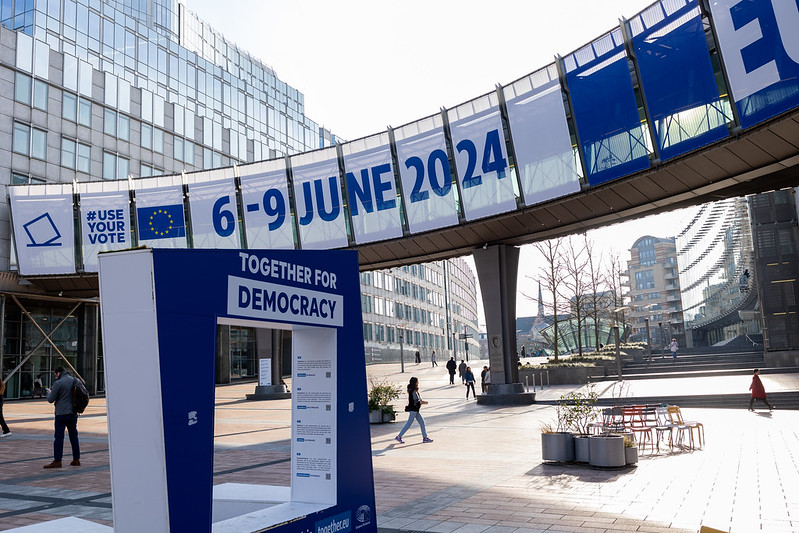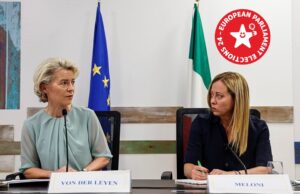To understand the nature of the current balance of power in the run-up to the European elections, we cannot simply frame it as a choice between “security” and the “Green Deal.” What is needed is a comprehensive policy that balances both economic stability and environmental protection. It would mean creating a sustainable, integral concept for the future of Europe. The only way to achieve such a goal is to form the broadest possible socio-political alliances. In this respect, the upcoming European elections will be decisive for the future of the EU.
Europe has been shifting to the right for a long time. However, the scope of the change since 2019 has been palpable amid the continuing weakness of left-wing parties in Europe. This includes the significant decline among the Greens and the slight losses among the Social Democrats/Socialists. Instead, it is the conservative and, significantly, right-wing extremist parties that have strengthened their position in the last five years, particularly in the core countries of the EU. Recent polls for the upcoming elections in June 2024 also reflect this. Right-wing extremist parties have already established themselves in most EU countries: in Italy and Finland, they even formed governments; in Sweden, they supported the governing coalition. One bright exception was in the Netherlands, where Geert Wilders failed to form his own right-wing government. Despite this, today right-wing parties are the strongest force in Belgium, France, Italy, the Netherlands, Austria, Hungary, and Poland. Meanwhile, in Germany, Portugal, Romania, and Spain, they occupy the second or third place in the polls. There are only six EU countries in which Social Democrats/Socialists are the leading political force, and only in Ireland is a left-wing party (Sinn Fein) actually leading the polls.
The Rightward Turn in the European Parliament: Majority Still Only Possible with Grand Coalition
Currently, a coalition of the Left, Greens, and Social Democrats/Socialists would garner about 30% across Europe. A “grand coalition” of Social Democrats and Conservatives, together with the Liberals, would have a clear majority in the next EU Parliament with approximately 55-57%. In contrast, the Conservatives, Social Democrats and Greens could piece together a very slim majority (about 51%). Right-wing parties also have another path, however, to forming majorities on the European level. A majority could emerge if the Conservatives banded together with two other right-wing factions in the European Parliament—the European Conservatives and Reformists (ECR) and the right-wing extremist and nationalist parties, along with the right-wing extremist “Identity and Democracy” faction and parties. This also includes parties that lie on the spectrum of the far right. This center-right bloc would currently receive a majority of 51-56%.
The Political Right Still on the Advance
There have been recent changes in the European Council and in the EU Commission due to the national shift to the right—changes that would be a boon to a newly strengthened right-wing bloc in the EP. With Giorgia Meloni as Prime Minister of Italy, the far-right Fratelli d’Italia (FDI) is also represented on the EU Council. Meloni’s Finnish colleague Petteri Orpo (KOK) is in a coalition with the far-right “Finns” party. Swedish Prime Minister Ulf Kristersson accepts support for his minority government from the Swedish Democrats. In Austria, meanwhile, sitting Austrian Chancellor Karl Nehammer (ÖVP) has advocated previously for forming a government with the FPÖ in his former position as Interior Minister in the first Kurz cabinet. Nor should one forget the case of Geert Wilders in the Netherlands, in which his party only narrowly failed to form a government after winning the election, or Viktor Orbán’s authoritarian government in Hungary, which is becoming increasingly incompatible with European democratic values.
In other words, there is no real bulwark against the right, and the political right is becoming more powerful. The adoption of the “Common European Asylum System” (CEAS) with closed camps at the EU’s external borders, the detention of asylum-seeking children, the omission of legal representation in asylum procedures, and the direct deportation of people from purportedly safe third countries would not have been possible without the attendant rightward drift in the political system on the whole, especially among Liberals, Social Democrats, and Conservatives. Resistance to this from parts of the Greens, individual Social Democrats, and the Left group has been too little to make a difference. On the national level, the way was paved by social democratic parties, for instance, in Denmark and Sweden, and by right-wing populist discourses in conservative and liberal parties.
On top of this came the many crises of recent years: the financial and economic crisis of 2008/2009; austerity policies and the dismantling of social infrastructure and the accelerated privatisation of public services; the pandemic; the climate crisis, which has already long begun to penetrate everyday life; and finally, the war in Ukraine and its consequences for EU countries—the inflation that is now on the decline but remains high, soaring food and energy prices. All of this has led to a rising sense of insecurity among many people, which drives them towards the right, especially when democratic parties cannot provide adequate answers to the challenges ahead.
Center-Right Parties’ Election Programmes Focus on Security Policy
As a result of this, Conservatives, Liberals, and Social Democrats are placing security issues dead center in their election programs. For Conservatives and Liberals, this is a question of the military protection of the EU, including its external borders, the independent development of the European economy, and its ability to compete globally. They are most preoccupied—and this has the support of the European Greens as well—with protecting Europe against authoritarian governments, like the Putin regime, developing the EU’s strategic economy, and defending European values such as freedom, justice, and democracy. This is directed against Russia and also, partly, against China.
To achieve this, the EU must be able to stand on its own two feet and simultaneously work together with its allies. This means, for Conservatives and Liberals, that all EU countries must invest in their defense capabilities in order to turn the EU into a European Defense Union by 2040 (ALDE): by land, by sea, by air, and in space. Although NATO remains the primary structure for military cooperation, EU defense policy needs to be reviewed and strengthened through the development of its own military-industrial and production capacities, which are to be secured by investment programs. The appointment of a European Commissioner for Security and Defense is intended to ensure a unified concept of security and defense. They call for the promotion of independent European strategic military capabilities, a European internal market for defense goods, and common rules for arms exports (EVP), along with establishing a defense budget within the multiannual financial framework to include a fund for military missions abroad. Liberals also recommend public-private partnerships for the use of digital technologies in warfare. Another aspect of this would be to abolish the unanimity principle in foreign and security policy, establish a Foreign Minister as the Vice President of the European Commission, and create an EU Security Council (EVP).
The Social Democrats and Greens have not commented on some of the proposals mentioned here by Conservatives and Liberals. But they also advocate for an alliance with NATO while simultaneously developing independent resources, i.e., developing the European defense industry through coordinated spending and increased joint procurement. Greens also call for promoting interoperability and coordinating procurement, maintenance, and supply systems.
However, the Social Democrats and Greens have also been advocating for strengthening a European External Action Service, expanding the EU’s diplomatic and political role in the world, while calling to support international law. In addition, the Greens also call for nuclear and conventional arms control and disarmament, for a ban on autonomous lethal weapons, and to support the Nuclear Non-Proliferation Treaty and the nonproliferation of atomic weapons. They are supported in this by the Left, which rejects war as a means of solving international conflicts, wants to put an end to the arms race, to the stationing of new nuclear weapons, and calls for the implementation of the Nuclear Non-Proliferation Treaty. Only the Party of the European Left calls for a reduction in the share of military spending as a percentage of GDP. Its preference is to develop neutrality and non-alignment as guiding principles for a peaceful European security order and is advocating for an agenda of peace, security, and disarmament. However, given the emerging balance of power of an ascendant grand coalition with the Liberals—and supported by the European Conservatives and Reformists (ECR) in security questions—the idea of security promoted by Conservatives and Liberals and the expansion of the EU as a defense union seem to preclude the possibility of non-military paths to peace, as advocated by the Social Democrats, Greens and, especially, the Left, and to what extent the core idea of a European Green Deal can continue to exist.
Perspectives on the European Green Deal: The “Green Social Deal,” the “Green Deal with a Red Heart,” or Integral Ecology?
The “European Green Deal” announced in 2019 is seen by Conservatives and Liberals as a subordinate element of the EU’s strategic autonomy, especially in terms of the fundamental energy sectors of the EU, and as a component of an independent, modern, and globally competitive economic and industrial development. This means that the Green Deal’s primary focus would be on measures for energy efficiency and promoting EU energy independence and the global competitiveness of the EU economy in the future.
The Liberals envision that a European Environmental Agency would be responsible for implementing this as an authority for monitoring compliance with EU energy and climate legislation and resolutions for energy efficiency. Conservatives mainly hope to strengthen European carbon-neutral and globally competitive industries, while Liberals want to keep the technology open. Whatever the case, both hold that the supply of critical raw materials should be ensured in accordance with the “Critical Raw Materials Act.” Conservatives and Greens also see potential for energy efficiency in strengthening local or regional “closed loop” economies, which could also integrate marginalised regions.
Liberals, however, see no room for expanding the Green Deal through additional investments outside scientific and economic programs. Certainly not in the way envisioned by the Greens, who propose to implement a holistic concept of a “Green and Social Deal” that would change Europe, an idea developed in their election program in almost all questions of policy and living. The Social Democrats, with their call for a social extension of the Green Deal as a “Green Deal with a Red Heart,” do not go quite as far, but they do advocate for an EU capacity for sustainable investment and the continuation of programs like NextGenerationEU and SURE, programs which combine growth and economic resilience with measures against growth social inequality. The Left combines the idea of the “Green and Social Deal” with the concept of socio-ecological transformation, and calls for an integral ecology that not only targets fossil-based production and modes of living but also opposes war, armament, and militarisation. Furthermore, for the Left, climate neutrality in the EU should be achieved not by 2050, but by 2035 at the latest, and they underpin this with concrete demands that would culminate in a new agroecological policy model.
Challenges That Can Only Be Met with New Forms of Political Cooperation
How, then, can these demands be implemented? Greens, Social Democrats, and the Left currently have about 30% representation. Even with the Liberals, they would only receive over 40%. But the latter’s statements about the supposed “overregulation” of the EU or an EU policy of prohibition, insistence on technological openness and the mythical prospect of decoupling growth and its effects on the climate and health—all this clearly distances them from the Greens.
This means that supporters of a “Green Social Deal” or a “Green Deal with a Red Heart” or a future “integral ecology” must focus above all on building the broadest social alliances possible: with social movements, representatives of religious communities, civil society initiatives, and trade unions, which have already long been at work on fair transitions for a socio-ecological transformation with their concept of a “just transition.” This alliance-building work must be linked to new forms of political cooperation. If one compares the election programs of the Social Democrats, the Greens, and the Left side by side, one already can notice the multiple overlapping aims and demands in social and ecological issues, in questions of the future of work, the defense of workers’ rights, as well as in feminist issues—the Social Democrats, for instance, speak of a “feminist Europe.” These common visions and demands must be brought into public debate and discussed.
Cover Photo: European Parliament on flickr.com



